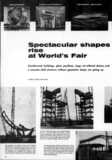
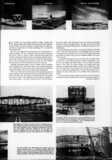
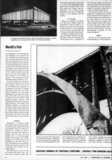
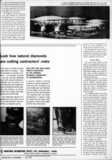
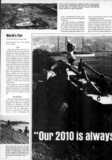
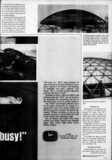
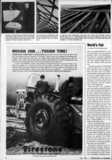
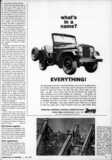
Cantilevered buildings, glass pavilions, huge air-inflated domes, and a concrete shell structure without geometric shape are going up
It is a fantastic city. One building resembles a bridge. Another looks like a plastic bubble. Still another has the aspect of a lunar landscape. These and about 140 more buildings of unique design are under construction on a square-mile plot of land in Flushing, N. Y., for the New York World's Fair.
The area is as congested with construction as the working floor of a concrete building. The site reverberates with the steady pounding of pile drivers. Cranes – forest of them – swing their long booms back and forth setting steel, placing concrete, and hoisting materials. Men – a small army of them - shape the steel and concrete into unaccustomed forms. Men and machines push toward an April 22, 1964, deadline that will mark the end of construction and the start of the fair.
[…]
Unisphere
[…]
U. S. Pavilion
[…]
Heliport
[…]
General Motors
[…]
Ford
Just a short distance from the General Motors site, a keen competitor is putting up a building complex of comparable size. The Ford Motor Co. pavilion consists of a 235-foot-diameter circular building adjoining a 500-foot-long box-shaped structure as high as a 7-story building. The large retangular structure will house show and entertainment features created by Walt Disney.
Designed by Welton Becket Associates, both buildings are framed in steel. The glass-enclosed circular pavilion is framed at its outer edges by 64 fingerlike columns that extend above the roof to a total height of 100 feet. A spider-web pattern of steel girders leading to a central column forms the roof structure.
Steel erection by American Bridge was completed this spring. Thompson Starrett Construction Co., the general contractor, expects to have the building ready to receive the displays by early fall.
Bell Telephone
[…]
The first curvilinear lamella dome to be built in this country will roof the General Electric Co.'s pavilion at the fair. The 200-foot-diameter dome is a latticework of steel pipes containing no interior supports or trusses. The two layers of curving steel pipes of the structural shell intersect each other at an angle to form a diamond-shaped pattern. Latitude rings tie the structure together. The dome is supported by a saw-tooth pattern of pipe columns resting on a 17-foot-high concrete wall.
The 5-inch-diameter meridian members rise from a massive ring girder to a 40-foot-diameter lantern ring at the top of the dome. The twelve latitude rings are of 4-inch tubing. At points of intersection, the ring steel is bolted to both of the diagonally crossing meridian members, by means of an offsetting saddle.
Fabrication and erection of the dome by Bethlehem Steel Co. have been tricky. The tubing has to be rolled precisely to conform to the exact curvature of the dome. Since bolt holes are predrilled, the entire structure has to fit together within very close tolerances.
In the construction, the meridian tubing arrives on the job in about 30-foot lengths. Three of the lengths are welded together in a jig on the ground to form the 89-foot-long meridian. Erection is a complex procedure, for three separate layers of steel must be tied together in a close sequence. With three intermediate rings supported on tubular towers, a crane first sets in place 14 of the lower meridian members and then 14 of the upper members. Erection proceeds in a balanced pattern.
The roofing is tied to the lower ring steel leaving the latticework of 5-inch tubing exposed to view. The roof is built up of metal decking welded by saddles to the ring steel. The sheeting is covered with 2 inches of fiberglass insulation that is topped with ½-inch plywood. A newly developed General Electric silicone-rubber experimental coating on the plywood forms the waterproof membrane.
Turner Construction Co. is the general contractor, and Welton Becket Associates is the architect for this unique dome. R. R. Bradshaw is the structural designer.
[…]